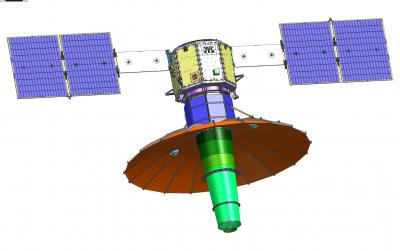SCIENCE
NRL launches TacSat-4 to augment communications needs
The Navy's Tactical Satellite-IV (TacSat-4) successfully launched Sept. 27 aboard an Orbital Sciences Minotaur-IV+ launch vehicle from Alaska Aerospace Corporation's (AAC) Kodiak Launch Complex, Kodiak Island, Alaska.
The spacecraft augments current geosynchronous satellite communications, having an apogee of 12,050 kilometers in the high latitudes to deliver near, although not continuous, global communications on-the-move (COTM) to the battlefield and provide access to mountainous regions that have previously proved problematic.
TacSat-4 is a Navy-led joint mission that provides 10 Ultra High Frequency (UHF) channels and allows forward deployed troops to communicate from obscured regions using existing hand-held radios without the need to stop and point an antenna towards the satellite.
"TacSat-4 supports a critical warfighting requirement: communication," said Chief of Naval Research Rear Adm. Nevin Carr. "We've developed a technology that will supplement traditional satellites, giving military personnel on the ground another outlet for data transmission and facilitating 'comms on the move,'"
TacSat-4 provides flexible up and down channel assignments, which increase the ability to operate in busy radio-frequency environments and will cover the high latitudes and mountainous areas where users currently cannot access UHF satellite communications (SATCOMs). The NRL Blossom Point Ground Station provides the command and control for TacSat-4 and maintains its user Virtual Mission Operations Center (VMOC) tasking system, allowing dynamic reallocation to different theaters worldwide and enabling rapid SATCOM augmentation when unexpected operations or natural events occur.
TacSat-4 is an experimental spacecraft that will test advances in several technologies and SATCOM techniques. It will augment the existing fleet by giving the SATCOM Support Centers (SSC) an additional space asset to provide communications to otherwise under-served users and areas that either do not have high enough priority or do not have satellite visibility. The project will potentially provide the option for launching smaller highly elliptical orbit (HEO) satellites and enabling 24-hour coverage in multiple regions simultaneously, allowing the military to achieve the benefits of a combined HEO and geosynchronous orbit constellation.
The spacecraft bus was built by NRL and Johns Hopkins University Applied Physics Laboratory (APL) to mature ORS bus standards. It was developed by an Integrated (government and industry) System Engineering Team, the "ISET Team," with active representation from AeroAstro, Air Force Research Laboratory, Johns Hopkins Laboratory APL, ATK Space, Ball Aerospace and Technologies, Boeing, Design Net Engineering, General Dynamics AIS, Microcosm, Microsat Systems Inc., Massachusetts Institute of Technology Lincoln Laboratory, Orbital Sciences, NRL, SMC, Space System Loral, and Raytheon.
{dmMaps strt="1317257935" DO NOT EDIT/REMOVE, HIDDEN ON THE FRONTEND ;) }
